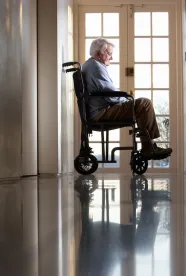With millions of COVID-19 vaccinations having been administered to nursing home residents and staff, the federal government is now encouraging in-person visitation in nursing homes. On March 10, 2021, the Centers for Medicare & Medicaid Services (CMS) updated its guidance to facilities regarding in-person visitation. Importantly, the updated memorandum, QSO-20-39-NH Revised (“CMS Memo”), provides revised guidance regarding indoor visitation, indoor visitation during an outbreak, core principles of COVID-19 infection prevention, outdoor visitation, visitor testing and vaccination and compassionate care visits.
Indoor Visitation & Indoor Visitation during an Outbreak
The most significant aspect of the new guidance addresses indoor visitation and indoor visitation during an outbreak. Nursing homes should allow indoor visitation at all times and for all residents, except for a few limited circumstances. Indoor visitation should be limited for:
-
Unvaccinated residents, if the nursing home’s COVID-19 county positivity rate is greater than 10% and less than 70% of the residents in the facility are fully vaccinated.
-
Residents with confirmed COVID-19 infection, whether vaccinated or unvaccinated, until they have met the criteria to discontinue Transmission-Based Precautions per CDC guidance.
-
Residents in quarantine, whether vaccinated or unvaccinated until they have met the criteria for release from quarantine.
Additionally, although CDC and CMS recommend facilities, residents, and families practice social distancing, if a resident is fully vaccinated, the resident “can choose to have close contact (including touch) with their visitor while wearing a well-fitting face mask and performing hand-hygiene before and after.”
When one COVID-19 case is detected in a nursing home, there are often other residents and staff who are infected. Accordingly, a single new COVID-19 case among residents or staff is considered an outbreak. CMS guidance provides that “[w]hen a new case of COVID-19 among residents or staff is identified, a facility should immediately begin outbreak testing and suspend all visitation (except that required under federal disability rights law) until at least one round of facility-wide testing is completed.” That said, facilities may resume visitation in the following situations:
-
If the first round of outbreak testing reveals no additional COVID-19 cases in other areas (e.g., units) of the facility, then visitation can resume for residents in areas/units with no COVID-19 cases. However, the facility should suspend visitation on the affected unit until testing identifies no new COVID cases among staff or residents for at least 14 days since the most recent positive result – the criteria to discontinue outbreak testing.
-
If the first round of outbreak testing reveals one or more additional COVID-19 cases in other areas/units of the facility (e.g., new cases in two or more units), then facilities should suspend visitation for all residents (vaccinated and unvaccinated) until the facility meets the criteria to discontinue outbreak testing.
While the above demonstrates that visitation may continue during an outbreak, facilities should be sure to continue all rounds of outbreak testing. Additionally, visitors should be notified about the potential for COVID-19 exposure in the facility via appropriate signage or other means.
Other Important Guidance for Facilities to Consider
By now, the general population is familiar with CDC guidelines that reduce the risk of COVID-19 transmission (e.g., wear a face covering or mask, maintain social distancing of at least 6 feet, and practice hand hygiene). In addition to adhering to these guidelines, facilities should also be sure to screen all who enter the facility for signs and symptoms of COVID-19 (e.g., temperature checks, questions about, and observations of signs or symptoms). Facilities then may deny entry to those with signs or symptoms. However, the updated CMS Memo now advises facilities to also deny entry to those who have had close contact with someone with COVID-19 infection in the prior 14 days (regardless of the visitor’s vaccination status).
Generally, outdoor visits pose a lower risk of transmission. As such, facilities are directed to hold visits outdoors whenever practicable, even when the resident and visitor are fully vaccinated. Of course, a resident’s health status or weather considerations (e.g., sub-freezing temperatures in Wisconsin or blazing temperatures in Florida) may prevent outdoor visits. Additionally, as COVID-19 vaccinations continue to become available to more members of the public, visitors of facilities are encouraged to get vaccinated when they have the opportunity. That said, a facility cannot require visitors to be tested or vaccinated (or show proof of such) as a condition of visitation.
Lastly, pursuant to the updated guidance, compassionate care visits should be “allowed at all times regardless of a resident’s vaccination status, the county’s COVID-19 positivity rate, or an outbreak.” As noted above, the resident may choose to have close contact with their visitor, so long as the resident is fully vaccinated. Furthermore, while compassionate care situations are often thought to apply to end-of-life situations, it is important for facilities to consider other situations that would be consistent with the intent of compassionate care situations.
Conclusion
Federal law prohibits a facility from restricting visitation without a reasonable clinical or safety cause. 42 CFR § 483.10(f) (4) (v). As such, it is important for nursing home facilities to carefully review, and apply, the guidance set forth in the updated CMS Memo.




 />i
/>i

